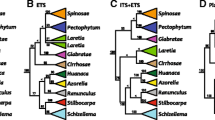Phyllostachys
, a large, economically important genus of woody bamboos. DNA sequences of the internal transcribed spacer (ITS) region of nuclear ribosomal DNA (nrDNA) were used in a parsimony analysis. Phyllostachys was well supported as monophyletic with Chimonobambusa as its closest allied genus. The 5S spacer region of nrDNA was investigated but found unsuitable for this purpose. The AFLP analysis showed much higher discriminating power between species and was more useful for phylogenetic reconstruction at this taxonomic level. The combined data were used to review the previous infra-generic classifications. Section Heteroclada Wang & Ye is strongly supported and can be further divided into sub-groups. A group within section Phyllostachys is strongly supported, but a further group of taxa previously included in this section is difficult to place. The ability of the methods to help separate species such as P. sulphurea and investigate genetic diversity at the infra-specific level was also assessed. It is argued that AFLPs could often be the method of choice for phylogenetic studies of closely related taxa for which DNA sequence data provide insufficient resolution.
Similar content being viewed by others
Author information
Authors and Affiliations
Additional information
Received 18 April 2000/ Accepted in revised form 10 June 2000
Rights and permissions
About this article
Cite this article
Hodkinson, T., Renvoize, S., Chonghaile, G. et al. A Comparison of ITS Nuclear rDNA Sequence Data and AFLP Markers for Phylogenetic Studies in Phyllostachys (Bambusoideae, Poaceae). J Plant Res 113, 259–269 (2000). https://doi.org/10.1007/PL00013936
Issue Date:
DOI: https://doi.org/10.1007/PL00013936




